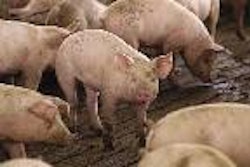
Diseases of ducks affecting birds around the world can be conveniently divided based on the causal agent. Nevertheless, the basic rules of biosecurity and disease control apply to the prevention of most diseases, whatever the causal organism.
Bacterial diseases
E. coli
This is by far the most common bacterial infection of all ages of commercial ducks and can certainly have the largest economic effect. In common with other classes of poultry, Escherichia coli infections can affect chicks, growing birds and parent stock. Being an environmental organism, it can act as a primary causal organism or secondary to other infections such as viruses or management problems which may affect the flock.
Signs in affected birds can vary from sudden death to birds being ‘off-colour’ with their necks pulled into their bodies.
Post mortem signs are similar to those in the fowl or turkeys. Acute infections may only show a congested carcass, congested lungs and small haemorrhages of the heart and air sacs. However more chronic infections will show the characteristic lesions of pericarditis, perihepatitis, enlargement of the liver, air sacculitis and pneumonia. In breeding birds, the presence of peritonitis and salpingitis is very common.
Diagnosis is relatively straightforward, based on the post mortem findings and a rapid growth of the organism on blood or MacConkey agar.
Control of this disease centres around improving hygiene in both laying and commercial farms. Poor standards of cleanliness within the house, combined with high levels of bacterial contamination of the drinking water system, will pre-dispose to this disease. Obviously, contamination of the eggs on the breeding farm or at the hatchery will also lead to yolk sac infections by E. coli. An audit of these areas is very important in attempting to reduce the impact of infections. Antibiotic therapy based on sensitivity data from post mortem cultures can be effective in combating infections. The use of commercial inactivated E. coli or autogenous vaccines may be considered when severe problems affect a flock or integrated company.
Salmonella infections
True salmonellosis is comparatively rare in ducks but is often due to the serotype Salmonella typhimurium. Clinical infections in commercial flocks usually follow a breakdown in hygiene measures on the breeder farm or at the hatchery as described for E. coli.
Affected birds are usually aged between 3 and 12 days, appear to be depressed and can show signs of scour. Post mortem signs include acute dehydration, septicaemia, acute enteritis and the classical caecal cores of white caseous material. Mortality levels in a flock can be quite significant, sometimes reaching 15%.
Routine sampling of flocks often reveals quite high levels of salmonella infections with no clinical signs evident. Although these infections do not have major economic effects on bird performance, pressure to eradicate is often brought to bear on the producer by end-users such as supermarkets. Serotypes such as S. Indiana are common on certain farms. It would appear that these infections can become endemic on commercial farms, and eradication can be difficult with re-cycling of the organism from crop to crop. Eradication measures include improved rodent control, water sanitisation, improved house hygiene, and possibly the use of competitive exclusion products.
Streptococcal infections
Increased levels of mortality at around 10 to 14 days of age in commercial flocks have been implicated with infection by Streptococcus zooepidemicus. Post mortem findings include congested carcasses, enlarged and mottled spleens and often air sacculitis. The cause of air sacculitis in this instance has not been ascertained. Poor levels of hygiene have again been implicated as a contributing factor to this disease. Affected flocks usually respond very well to treatment with antibiotics such as amoxycillin.
Pasteurella infections
Infections with Pasteurella multocida (fowl cholera) in ducks are extremely common across the world. This organism is very common in Asia and the Middle East countries. Signs in acute outbreaks can be just sudden death in large numbers of birds; however, in chronic infections, signs of depression, conjunctivitis and dyspnoea can occur. Diagnosis is relatively straightforward by bacterial culture, although the organism can be masked by overgrowth of bacteria such as E. coli. Infections are not thought to be passed vertically but can remain resident on a farm for many cycles of production. Rats are certainly known to be a reservoir for P. multocida and transfer between birds can occur through infected water and around feed troughs.
Treatment of peracute or acute cases is almost impossible with antibiotics. Chronic cases may respond to tetracyclines but the improvements only tend to last as long as the treatments. Vaccination using multi-strain inactivated vaccines can be effective in preventing infection, although autogenous vaccines are usually more successful. The depopulation of the affected site, thorough cleansing and disinfection of the buildings and equipment and strict rodent elimination are the best long term controls of this disease.
Riemerella anatipestifer causes disease in ducks throughout the world. Formerly known as Pasteurella anatipestifer, this organism usually causes disease in young ducklings aged between 2 and 6 weeks. The organism is thought to be vertically transmitted through the egg and lateral transmission occurs via the respiratory route. Stress factors such as moving birds and environmental variations can trigger disease. Signs usually include head shaking, lethargy and an abnormal gait. Post mortem signs in acute cases include enlargement of the liver and spleen and lung congestion. In more chronic cases, pericarditis, perihepatitis and air sacculitis with a caseous deposit can be found. Treatment with a range of antibiotics has been found to be successful. Prevention is best achieved with good hygiene and husbandry and by avoiding stress in the flock where possible.
Fungal infections
Fungal conditions such as aspergillosis can be a major factor affecting duck health.
Straw bedding will obviously allow the ingress of fungal spores into the duck house. These can cause significant mortality in young ducklings or older birds under stress, for example, breeding birds. Checking straw for levels of fungal spores especially in areas of the world where this is prevalent can be beneficial in selecting suitable bedding material.
Viral infections
Duck virus hepatitis (DVH)
Although this disease was first described in the USA, it has been diagnosed all around the world. It has since usually become endemic in those regions.
DVH affects young ducklings between 2 and 21 days of age. It usually presents as an acute disease, affected birds dying within a few hours of showing clinical signs. Birds usually die in good condition with their heads stretched upwards in opisthotonus. Mortality may reach 90% although typically, this is more likely to be 10%. Post mortem signs include an enlarged liver with petechial and ecchymotic haemorrhages. These clinical findings are diagnostic. Control is normally effective using a live vaccine in the foot in one-day-old ducks.
Duck virus enteritis (DVE; duck plague)
This viral infection was first diagnosed in 1949 in the Netherlands but has since been diagnosed in the USA, Europe and other duck-rearing areas of the world. Mortality can also reach 90% with a swift onset of clinical signs. These include conjunctivitis, nasal discharge, inappetence, soiled vents and watery diarrhoea. Spread appears to be more rapid when birds have access to swimming water. Birds usually die in good bodily condition. Vascular damage characterises this condition with haemorrhages on the heart, liver, pancreas, intestines, lungs and kidneys. Haemorrhages are also very common on the mucosal surface of the alimentary tract. Later in the disease progression, yellow diphtheritic plaques develop in the oesophagus and cloaca, which are fairly diagnostic of the disease.
A live vaccine exists which when inoculated into susceptible stock should give reasonable protection.
Avian influenza and Newcastle disease
The recent global spread of highly pathogenic avian influenza virus H5N1 has highlighted the association between wild birds and domestic poultry. Recent outbreaks in Asia have shown that ducks appear to be particularly susceptible to infection with this virus. The evidence suggests that there is an increased risk of transmission of H5N1 virus from wild fowl and other carriers to ducks reared commercially in extensive systems in Asia. Similar experiences in many parts of the world have shown that Newcastle disease can become endemic in natural bird populations, making control and eradication difficult.
General advice
Endemic disease in wild bird populations puts extra pressure on producers to improve hygiene and biosecurity.
Establishing the duck farm geographically apart from other poultry sites is a major advantage. The presence of a perimeter barrier to help stop the passage of unwanted persons and vehicles onto the site is also important. The logging of people onto a farm is an essential part of control measures and it has been shown that vehicles can be important vectors for disease transmission from site to site.
Using specific clothing and footwear for the site and indeed for specific houses is an important way to stop disease entering the duck houses. Enforcing this can be difficult, so the use of step-over barriers at the entrance to the house can be useful. Foot dips – protected from the ultra-violet rays in sunlight – should also be used at these points. People often forget to include hand-wash facilities at the entrances to poultry houses and yet it has been shown that transmission from the hands of workers can be instrumental in helping disease pass from bird to bird. As discussed previously for the control of bacterial diseases such as salmonella, the prevention of access to the poultry house by wild birds and vermin will also reduce the risk of viruses gaining access.















